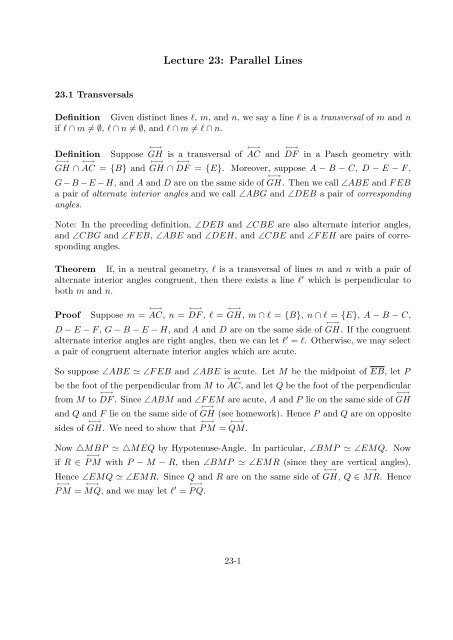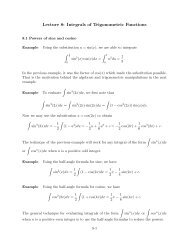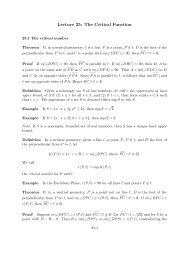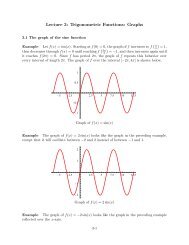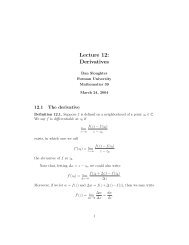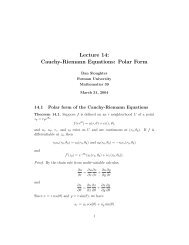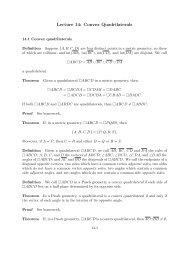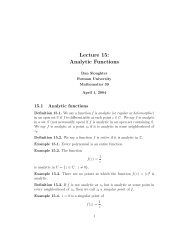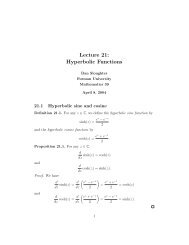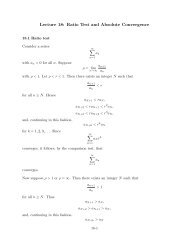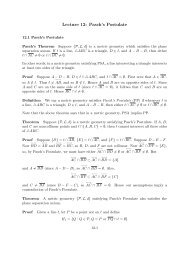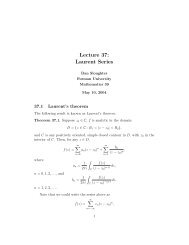corresponding
Lecture 23: Parallel Lines
Lecture 23: Parallel Lines
Create successful ePaper yourself
Turn your PDF publications into a flip-book with our unique Google optimized e-Paper software.
Lecture 23: Parallel Lines<br />
23.1 Transversals<br />
Definition Given distinct lines l, m, and n, we say a line l is a transversal of m and n<br />
if l ∩ m ≠ ∅, l ∩ n ≠ ∅, and l ∩ m ≠ l ∩ n.<br />
Definition Suppose GH ←→<br />
is a transversal of AC ←→<br />
and DF ←→<br />
in a Pasch geometry with<br />
←→<br />
GH ∩ AC ←→<br />
= {B} and GH ←→<br />
∩ DF ←→<br />
= {E}. Moreover, suppose A − B − C, D − E − F ,<br />
G − B − E − H, and A and D are on the same side of GH. ←→<br />
Then we call ∠ABE and F EB<br />
a pair of alternate interior angles and we call ∠ABG and ∠DEB a pair of <strong>corresponding</strong><br />
angles.<br />
Note: In the preceding definition, ∠DEB and ∠CBE are also alternate interior angles,<br />
and ∠CBG and ∠F EB, ∠ABE and ∠DEH, and ∠CBE and ∠F EH are pairs of <strong>corresponding</strong><br />
angles.<br />
Theorem If, in a neutral geometry, l is a transversal of lines m and n with a pair of<br />
alternate interior angles congruent, then there exists a line l ′ which is perpendicular to<br />
both m and n.<br />
Proof Suppose m = AC, ←→<br />
n = DF ←→<br />
, l = GH, ←→<br />
m ∩ l = {B}, n ∩ l = {E}, A − B − C,<br />
D − E − F , G − B − E − H, and A and D are on the same side of GH. ←→<br />
If the congruent<br />
alternate interior angles are right angles, then we can let l ′ = l. Otherwise, we may select<br />
a pair of congruent alternate interior angles which are acute.<br />
So suppose ∠ABE ≃ ∠F EB and ∠ABE is acute. Let M be the midpoint of EB, let P<br />
be the foot of the perpendicular from M to ←→<br />
AC, and let Q be the foot of the perpendicular<br />
from M to ←→<br />
DF . Since ∠ABM and ∠F EM are acute, A and P lie on the same side of ←→<br />
GH<br />
and Q and F lie on the same side of ←→<br />
GH (see homework). Hence P and Q are on opposite<br />
sides of ←→<br />
GH. We need to show that ←→<br />
P M = ←→<br />
QM.<br />
Now △MBP ≃ △MEQ by Hypotenuse-Angle. In particular, ∠BMP ≃ ∠EMQ. Now<br />
if R ∈ P ←→<br />
M with P − M − R, then ∠BMP ≃ ∠EMR (since they are vertical angles).<br />
Hence ∠EMQ ≃ ∠EMR. Since Q and R are on the same side of GH, ←→<br />
Q ∈ MR. −→<br />
Hence<br />
←→<br />
P M = MQ, ←→<br />
and we may let l ′ = P ←→<br />
Q.<br />
23-1
Lecture 23: Parallel Lines 23-2<br />
23.2 Parallel lines<br />
Theorem If, in a neutral geometry, l, m, and n are distinct lines with n ⊥ l and n ⊥ m,<br />
then l and m are parallel.<br />
Proof Let n ∩ l = {P }, n ∩ m = {Q}. If l ∩ m = {R}, then △P QR would have two<br />
right angles. Hence l ∩ m = ∅, that is, l and m are parallel.<br />
Theorem If, in a neutral geometry, lines l and m have a transversal with congruent<br />
alternate interior angles, then l and m are parallel.<br />
Note that in the Poincaré Plane, the lines 0 L and 1 L 1 are parallel but do not have a<br />
common perpendicular<br />
Theorem If, in a neutral geometry, P is a point, l is a line, and P /∈ l, then there exists<br />
a line through P parallel to l.<br />
Proof Let Q be the foot of the perpendicular from P to l and let m be the unique line<br />
through P perpendicular to P ←→<br />
Q. Then P ←→<br />
Q ⊥ m and P ←→<br />
Q ⊥ l, and so m and l are parallel.<br />
23.3 Euclid’s parallel postulate<br />
Definition We say a protractor geometry {P, L, d, m} satisfies Euclid’s Fifth Postulate<br />
(EFP) if whenever BC ←→<br />
is a transversal of AB ←→<br />
and CD ←→<br />
with A and D on the same side of<br />
←→<br />
BC and m(∠ABC) + m(∠(BCD) < 180, then AB ←→<br />
and CD ←→<br />
intersect at a point E on the<br />
same side of BC ←→<br />
as A and D.<br />
Theorem If, in a neutral geometry which also satisfies Euclid’s Fifth Postulate, P is a<br />
point, l is a line, and P /∈ l, then there exists a unique line through P parallel to l.<br />
Proof Let Q be the foot of the perpendicular from P to l and let m be the unique line<br />
through P perpendicular to P ←→<br />
Q. Then m is parallel to l, as above. Now suppose AB ←→<br />
is<br />
another line through P . Since ←→<br />
AB is not perpendicular to ←→<br />
P Q, one of ∠AP Q or ∠BP Q is<br />
acute. Since ←→<br />
P Q is perpendicular to l, Euclid’s Fifth Postulate implies that ←→<br />
AB ∩ l ≠ ∅.<br />
Definition We say an incidence geometry satisfies the Euclidean Parallel Property, denoted<br />
EPP, or Playfair’s Parallel Postulate, if for any line l and any point P there exists<br />
a unique line through P parallel to l.<br />
We have already seen that if a neutral geometry satisfies Euclid’s Fifth Postulate, then it<br />
satisfies the Euclidean Parallel Property. The next theorem says these axioms are equivalent.
Lecture 23: Parallel Lines 23-3<br />
Theorem A neutral geometry which satisfies the Euclidean Parallel Property also satisfies<br />
Euclid’s Fifth Postulate.<br />
Proof Let BC ←→<br />
be a transversal of AB ←→<br />
and CD ←→<br />
with A and D on the same side of BC ←→<br />
and<br />
m(∠ABC) + m(∠BCD) < 180. Let E be a point on the same side of BC ←→<br />
as A such that<br />
∠EBC and ∠BCD are supplementary. Let F be a point with F − B − E. Then ∠F BC<br />
and ∠EBC are a linear pair, hence supplementary, and so ∠F BC ≃ ∠BCD. Hence BE<br />
←→<br />
and CD ←→<br />
are parallel. Since BA −→<br />
≠ BE, −→<br />
it follows that AB ←→<br />
is not parallel to CD. ←→<br />
Hence<br />
←→<br />
AB ∩ CD ←→<br />
≠ ∅. It remains to show that BA −→<br />
∩ CD −→<br />
≠ ∅.<br />
Now ∠CBA < ∠CBE, so A ∈ int(∠CBE). In particular, A and C are on the same side<br />
of BE. ←→<br />
Hence int( BA) −→<br />
and CD ←→<br />
are on the same side of BE. ←→<br />
Thus BA −→<br />
∩ CD ←→<br />
≠ ∅. Finally,<br />
since int( BA) −→<br />
and int( CD) −→<br />
lie on the same side of BC, ←→<br />
we must have BA −→<br />
∩ CD −→<br />
≠ ∅.


